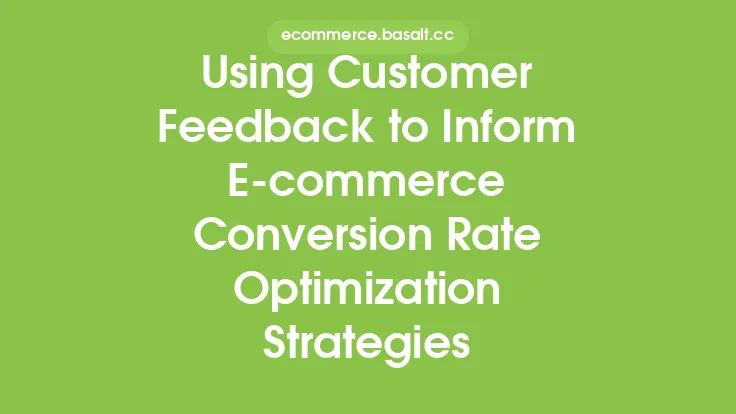In the competitive world of e-commerce, providing exceptional customer support is crucial for building trust, loyalty, and driving business growth. One of the most effective ways to improve e-commerce support is by leveraging customer feedback. Customer feedback is a valuable resource that can help e-commerce businesses identify areas of improvement, optimize their support processes, and ultimately deliver a better customer experience. In this article, we will explore the importance of customer feedback in e-commerce support, how to collect and analyze feedback, and strategies for using feedback to drive improvements.
Understanding the Importance of Customer Feedback
Customer feedback is a vital component of any e-commerce support strategy. It provides businesses with insights into the strengths and weaknesses of their support processes, helping them to identify areas that require improvement. By collecting and analyzing customer feedback, e-commerce businesses can gain a deeper understanding of their customers' needs, preferences, and pain points. This information can be used to inform support process improvements, optimize support channels, and enhance the overall customer experience. Furthermore, customer feedback can help e-commerce businesses to measure the effectiveness of their support processes, identify trends and patterns, and make data-driven decisions to drive continuous improvement.
Collecting Customer Feedback
Collecting customer feedback is a critical step in the process of using feedback to improve e-commerce support. There are several ways to collect customer feedback, including surveys, reviews, ratings, and social media listening. Surveys can be used to gather detailed feedback from customers, while reviews and ratings provide a quick and easy way for customers to share their experiences. Social media listening involves monitoring social media conversations about a brand or business, providing valuable insights into customer sentiment and feedback. Additionally, e-commerce businesses can collect feedback through support interactions, such as email, phone, or live chat. It is essential to make it easy for customers to provide feedback, by providing multiple channels and making the process as seamless as possible.
Analyzing Customer Feedback
Analyzing customer feedback is a crucial step in the process of using feedback to improve e-commerce support. There are several ways to analyze customer feedback, including manual analysis, automated analysis, and sentiment analysis. Manual analysis involves manually reviewing and categorizing customer feedback, while automated analysis uses software and algorithms to analyze feedback. Sentiment analysis involves analyzing customer feedback to determine the emotional tone and sentiment behind the feedback. By analyzing customer feedback, e-commerce businesses can identify trends and patterns, pinpoint areas of improvement, and develop strategies to address customer concerns. It is essential to analyze feedback in a timely and efficient manner, to ensure that insights are actionable and can be used to drive improvements.
Strategies for Using Feedback to Drive Improvements
There are several strategies that e-commerce businesses can use to drive improvements based on customer feedback. One strategy is to prioritize feedback based on urgency and impact, focusing on the most critical issues first. Another strategy is to use feedback to inform support process improvements, such as updating support documentation, developing new support channels, or enhancing support agent training. Additionally, e-commerce businesses can use feedback to optimize support channels, such as email, phone, or live chat, to ensure that customers can easily access support when they need it. Furthermore, feedback can be used to enhance the overall customer experience, by identifying areas where the business can improve, such as product quality, shipping, or returns.
Implementing Changes Based on Feedback
Implementing changes based on customer feedback is a critical step in the process of using feedback to improve e-commerce support. It is essential to communicate changes to customers, to ensure that they are aware of the improvements being made. E-commerce businesses should also monitor the effectiveness of changes, to ensure that they are having the desired impact. Additionally, businesses should continue to collect and analyze feedback, to ensure that the changes being made are meeting customer needs and expectations. By implementing changes based on customer feedback, e-commerce businesses can demonstrate their commitment to customer satisfaction, build trust, and drive loyalty.
Measuring the Impact of Feedback-Driven Improvements
Measuring the impact of feedback-driven improvements is essential to ensure that the changes being made are having the desired effect. There are several metrics that e-commerce businesses can use to measure the impact of feedback-driven improvements, including customer satisfaction, first contact resolution, and support ticket volume. Customer satisfaction metrics, such as CSAT or NPS, can be used to measure the effectiveness of support processes and identify areas for improvement. First contact resolution metrics can be used to measure the effectiveness of support agents and identify areas where additional training may be needed. Support ticket volume metrics can be used to measure the effectiveness of support processes and identify areas where improvements can be made. By measuring the impact of feedback-driven improvements, e-commerce businesses can ensure that they are making data-driven decisions and driving continuous improvement.
Best Practices for Using Customer Feedback
There are several best practices that e-commerce businesses can follow to ensure that they are using customer feedback effectively. One best practice is to make it easy for customers to provide feedback, by providing multiple channels and making the process as seamless as possible. Another best practice is to analyze feedback in a timely and efficient manner, to ensure that insights are actionable and can be used to drive improvements. Additionally, e-commerce businesses should prioritize feedback based on urgency and impact, focusing on the most critical issues first. Furthermore, businesses should communicate changes to customers, to ensure that they are aware of the improvements being made. By following these best practices, e-commerce businesses can ensure that they are using customer feedback effectively, driving continuous improvement, and delivering a better customer experience.
Conclusion
In conclusion, using customer feedback to improve e-commerce support is a critical component of any e-commerce strategy. By collecting and analyzing customer feedback, e-commerce businesses can gain a deeper understanding of their customers' needs, preferences, and pain points. By using feedback to drive improvements, e-commerce businesses can optimize their support processes, enhance the customer experience, and drive business growth. By following best practices, such as making it easy for customers to provide feedback, analyzing feedback in a timely and efficient manner, and prioritizing feedback based on urgency and impact, e-commerce businesses can ensure that they are using customer feedback effectively. Ultimately, using customer feedback to improve e-commerce support is essential for building trust, loyalty, and driving business success in the competitive world of e-commerce.





